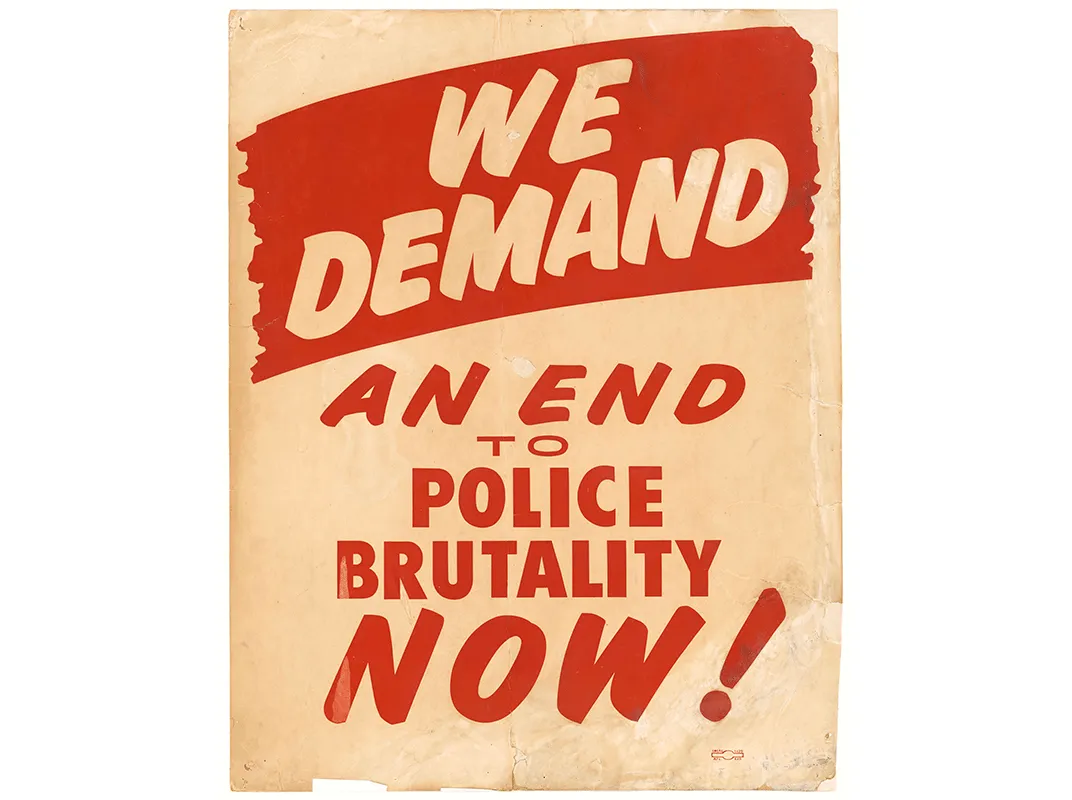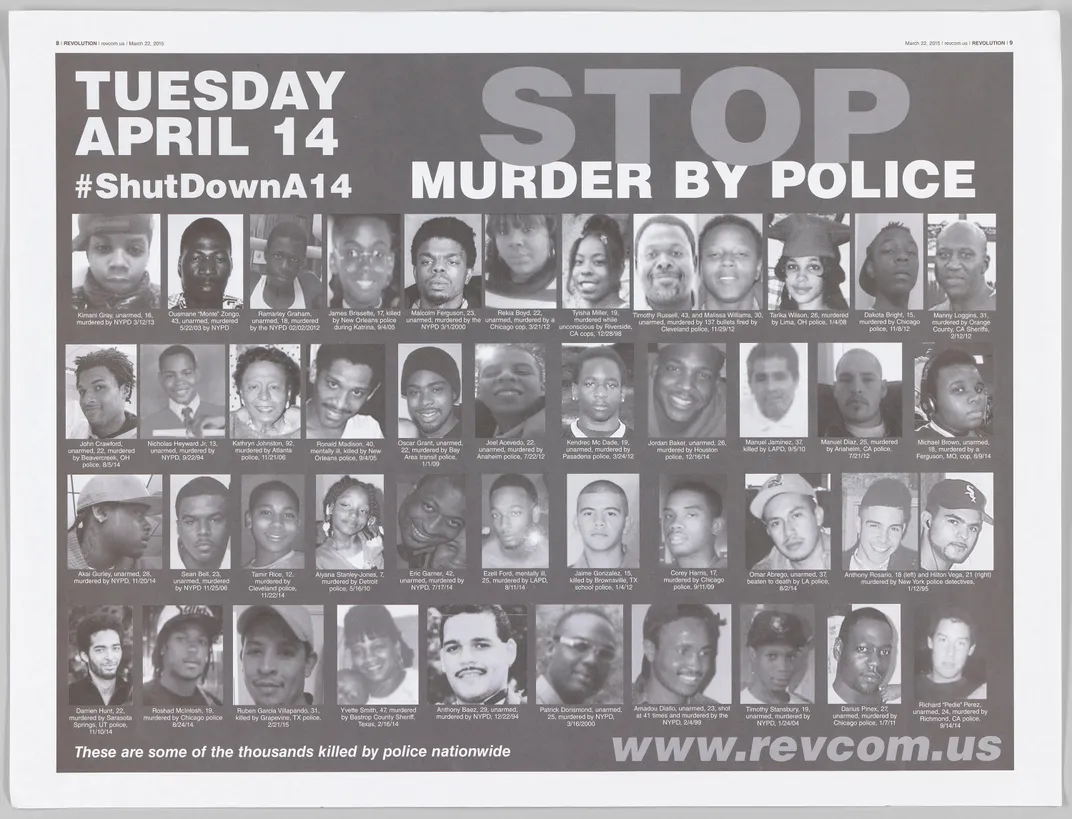The Long, Painful History of Police Brutality in the U.S.
A 1963 protest placard in the Smithsonian collections could almost be mistaken for any of the Black Lives Matter marches of today
:focal(-528x-528:-527x-527)/https://tf-cmsv2-smithsonianmag-media.s3.amazonaws.com/filer/db/be/dbbe83d7-7e01-4508-b66d-21f8271d58f9/cwccc9_1.jpg)
Editor's Note, May 29, 2020: In 2017, Smithsonian covered the history of police brutality upon the protests over the verdict in the Philando Castile murder case. With the Twin Cities once again under the national spotlight after the killing of George Floyd, we revisit the subject matter below.
Last month, hours after a jury acquitted former police officer Jeronimo Yanez of manslaughter in the shooting death of 32-year-old Philando Castile, protesters in St. Paul, Minnesota, shutdown Interstate 94. With signs that read: “Black Lives Matter” and “No Justice, No Peace,” the chant of “Philando, Philando” rang out as they marched down the highway in the dark of night.
The scene was familiar. A year earlier, massive protests had erupted when Yanez killed Castile, after pulling him over for a broken taillight. Dashcam footage shows Yanez firing through the open window of Castile’s car, seconds after Castile disclosed that he owned and was licensed to carry a concealed weapon.
A respected school nutritionist, Castile was one of 233 African-Americans shot and killed by police in 2016, a startling number when demographics are considered. African-Americans make up 13 percent of the U.S. population but account for 24 percent of people fatally shot by police. According to the Washington Post, blacks are "2.5 times as likely as white Americans to be shot and killed by police officers."
Today's stories are anything but a recent phenomenon. A cardboard placard in the collections of the Smithsonian's National Museum of African American History and Culture and on view in the new exhibition “More Than a Picture,” underscores that reality.

The yellowing sign is a reminder of the continuous oppression and violence that has disproportionately shaken black communities for generations—“We Demand an End to Police Brutality Now!” is painted in red and white letters.
“The message after 50 years is still unresolved,” remarks Samuel Egerton, a college professor, who donated the poster to the museum. He carried it in protest during the 1963 March on Washington. Five decades later, the poster’s message rings alarmingly timely. Were it not for the yellowed edges, the placard could almost be mistaken for a sign from any of the Black Lives Matter marches of the past three years.
"There are those who are asking the devotees of civil rights, ‘When will you be satisfied?" said Martin Luther King, Jr. in his iconic "I Have a Dream" speech at the 1963 march. His words continue to resonate today after a long history of violent confrontations between African-American citizens and the police. "We can never be satisfied as long as the Negro is the victim of the unspeakable horrors of police brutality."
"This idea of police brutality was very much on people’s minds in 1963, following on the years, decades really, of police abuse of power and then centuries of oppression of African-Americans," says William Pretzer, senior history curator at the museum.

Modern policing did not evolve into an organized institution until the 1830s and '40s when northern cities decided they needed better control over quickly growing populations. The first American police department was established in Boston in 1838. The communities most targeted by harsh tactics were recent European immigrants. But, as African-Americans fled the horrors of the Jim Crow south, they too became the victims of brutal and punitive policing in the northern cities where they sought refuge.
In 1929, the Illinois Association for Criminal Justice published the Illinois Crime Survey. Conducted between 1927 and 1928, the survey sought to analyze causes of high crime rates in Chicago and Cook County, especially among criminals associated with Al Capone. But also the survey provided data on police activity—although African-Americans made up just five percent of the area's population, they constituted 30 percent of the victims of police killings, the survey revealed.
"There was a lot of one-on-one conflict between police and citizens and a lot of it was initiated by the police," says Malcolm D. Holmes, a sociology professor at the University of Wyoming, who has researched and written about the topic of police brutality extensively.
That same year, President Herbert Hoover established the National Commission on Law Observance and Enforcement to investigate crime related to prohibition in addition to policing tactics. Between 1931 and 1932, the commission published the findings of its investigation in 14 volumes, one of which was titled “Report on Lawlessness in Law Enforcement.” The realities of police brutality came to light, even though the commission did not address racial disparities outright.
During the Civil Rights Era, though many of the movement's leaders advocated for peaceful protests, the 1960s were fraught with violent and destructive riots.
/https://tf-cmsv2-smithsonianmag-media.s3.amazonaws.com/filer/1b/55/1b558d42-ae6d-453b-936b-e42aa61d6654/2012_169_6.jpg)
Aggressive dispersion tactics, such as police dogs and fire hoses, against individuals in peaceful protests and sit-ins were the most widely publicized examples of police brutality in that era. But it was the pervasive violent policing in communities of color that built distrust at a local, everyday level.
One of the deadliest riots occurred in Newark in 1967 after police officers severely beat black cab driver John Smith during a traffic stop. Twenty-six people died and many others were injured during the four days of unrest. In 1968, President Lyndon B. Johnson organized the National Advisory Commission on Civil Disorders to investigate the causes of these major riots.
The origins of the unrest in Newark weren't unique in a police versus citizen incident. The commission concluded "police actions were 'final' incidents before the outbreak of violence in 12 of the 24 surveyed disorders.”
The commission identified segregation and poverty as indicators and published recommendations for reducing social inequalities, recommending an “expansion and reorientation of the urban renewal program to give priority to projects directly assisting low-income households to obtain adequate housing.” Johnson, however, rejected the commission’s recommendations.
Black newspapers reported incidents of police brutality throughout the early and mid-20th century and the popularization of radio storytelling spread those stories even further. In 1991, following the beating of cab driver Rodney King, video footage vividly told the story of police brutality on television to a much wider audience. The police officers, who were acquitted of the crime, had hit King more than 50 times with their batons.
Today, live streaming, tweets and Facebook posts have blasted the incidents of police brutality, beyond the black community and into the mainstream media. Philando Castile’s fiancée, Diamond Reynolds, who was in the car with her daughter when he was shot, streamed the immediate aftermath of the shooting on her phone using Facebook live.
"Modern technology allows, indeed insists, that the white community take notice of these kinds of situations and incidents," says Pretzer.
And as technology has evolved, so has the equipment of law enforcement. Police departments with military-grade equipment have become the norm in American cities. Images of police officers in helmets and body armor riding through neighborhoods in tanks accompany stories of protests whenever one of these incidents occurs.
"What we see is a continuation of an unequal relationship that has been exacerbated, made worse if you will, by the militarization and the increase in fire power of police forces around the country," says Pretzer.
The resolution to the problem, according to Pretzer, lies not only in improving these unbalanced police-community relationships, but, more importantly, in eradicating the social inequalities that perpetuate these relationships that sustain distrust and frustration on both sides.
'There’s a tendency to stereotype people as being more or less dangerous. There’s a reliance upon force that goes beyond what is necessary to accomplish police duty," says Holmes. "There’s a lot of this embedded in the police departments that helps foster this problem."
/https://tf-cmsv2-smithsonianmag-media.s3.amazonaws.com/accounts/headshot/DSC_0154.JPG.jpeg)
/https://tf-cmsv2-smithsonianmag-media.s3.amazonaws.com/accounts/headshot/DSC_0154.JPG.jpeg)